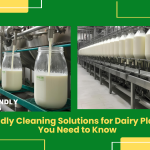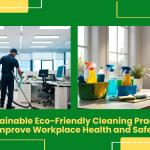A thoughtful approach to selecting the right Eco-Green Product ensures safe, effective cleaning without harming people or the planet. Conventional cleaners can emit volatile organic compounds (VOCs), abrade delicate finishes, or leave toxic residues that affect indoor air quality and long‐term surface integrity. By matching plant‐based surfactants, enzyme blends, and pH‐balanced formulas to specific materials, facilities can minimize chemical exposure, extend the life of furnishings, and cut maintenance costs. Prevention tips—such as using microfiber applicators and enforcing proper dilution—further safeguard surfaces and personnel. Leveraging Ecochem’s digital signage, you can display real‐time safety data, cleaning schedules, and SDS access across any screen, integrating with over 100 applications for seamless compliance tracking and staff training.
Problems with Mismatched Cleaning Products
Glass and Mirror Damage
Using alkaline or abrasive cleaners on glass can leave streaks, etchings, and residue, reducing visibility and aesthetic appeal. Ammonia‐based sprays may degrade mirror backing over time, leading to silvering and pit marks. Residual suds can attract dust and require repeated wiping, increasing labor and resource use.
Wood and Laminate Wear
High‐pH detergents strip natural oils from solid wood, causing dryness, warping, and fading. Abrasive granules in multipurpose powders scratch laminate finishes, compromising protective veneers. Over‐saturation with water can lead to swelling and delamination, necessitating premature floor or furniture replacement.
Natural Stone Corrosion
Marble, granite, and travertine surfaces are vulnerable to acidic cleaners, which dissolve calcium carbonates and leave etch marks. Phosphate‐laden detergents and chelators promote mineral precipitation, dulling polished stone and undermining sealants. Traditional degreasers may pool in pores, trapping grime.
Electronic Screen Hazards
Alcohol and solvent‐heavy formulas remove protective coatings on LCD and OLED displays, impair touch sensitivity, and introduce static build‐up that attracts particulates. Excess moisture from spray‐and‐wipe methods can seep into device seams, risking short circuits and data loss.
Stainless Steel Corrosion
Chlorine and bleach‐based cleaners pit and corrode stainless steel surfaces, leaving dark spots and compromising sanitary applications in kitchens and labs. High‐alkaline formulas can streak, requiring laborious polishing to restore luster.
Solutions: Surface‐Specific Eco‐Green Product Recommendations
Glass and Mirror—Ammonia‐Free Sprays
Choose an Eco‐Green Product formulated with nonionic biosurfactants and plant‐derived solvents like d-limonene to dissolve oils without streaking. Microfiber cloths capture loosened soils without abrasive action. Dilute at manufacturer guidelines (often 1:20) to prevent residue build‐up.
Wood and Laminate—pH‐Neutral Cleaner
Use an Eco‐Green Product with gentle, nonionic surfactants and natural chelators (e.g., sodium gluconate) at near‐neutral pH to protect wood finishes. Apply sparingly with a damp microfiber pad; avoid puddles. For deep cleans, incorporate plant‐based oils (e.g., jojoba) that replenish wood lipids.
Natural Stone—Mild Alkaline with Chelators
Select an Eco‐Green Product containing mild alkaline surfactants plus EDDS or sodium gluconate to lift soils without attacking stone. Rinse thoroughly and buff with a dry microfiber cloth. Reapply stone sealant periodically for long‐term protection.
Electronics—Isopropanol‐Free Screen Wipes
Opt for a water‐based Eco‐Green Product with nonionic surfactants and low‐ionic residue, delivered via pre‐moistened wipes. These remove fingerprints and smudges safely. Encourage staff to power down devices before cleaning to avoid damage.
Stainless Steel—Plant‐Based Solvent and Emollient Blend
An Eco‐Green Product with methyl soyate or other plant‐solvent base, combined with a food‐grade emulsifier, dissolves grease without pitting. Wipe with a grain‐conforming microfiber towel. Finish with a drop of natural oil (e.g., mineral oil) to restore shine.
High‐Traffic Floors—Enzyme and Biosurfactant Concentrate
Floors benefit from enzyme‐enhanced Eco‐Green Products that degrade organic spills at the molecular level, paired with anionic biosurfactants for soil suspension. Use with an automatic scrubber set to low dilution (1–2%). Microfiber pads trap debris and reduce water usage.
Restroom Fixtures—Antimicrobial Essential Oil Formulas
For toilets and urinals, choose an Eco‐Green Product incorporating botanical antimicrobials like tea tree or thyme oil, backed by biodegradable surfactants. These reduce odor-causing bacteria without corrosive acids. Apply via trigger spray and allow dwell time per label.
Kitchen Surfaces—Food‐Safe, Food‐Contact Cleansers
In food prep zones, use a certified Eco‐Green Product free of quaternary ammonium compounds and palatable essential oils, ensuring no toxic residues. Rinse thoroughly and air‐dry. Post-application, post training reminders on Ecochem signage to avoid cross‐contamination.
Prevention Tips: Protecting Surfaces and People
Standardize Dilution Protocols
Over‐dilution or under‐dilution of an Eco‐Green Product undermines performance. Use calibrated dosing systems or color‐coded dilution stations. Clearly post dilution ratios on Ecochem digital signage near cleaning closets.
Microfiber and Tool Hygiene
Microfiber tools retain soils; launder them at low temperature using phosphate-free detergents. Track wash cycles and retire pads after manufacturer’s lifespan. Automate replacement alerts through Ecochem’s CMMS integration.
Ventilation and Airflow
Maintain adequate air exchanges during and after cleaning. Install CO₂ and VOC sensors tied to Ecochem signage to display air quality metrics, prompting staff to open windows or activate HVAC boosts when thresholds exceed healthy levels.
Staff Training and Certification
Regularly update training modules on Ecochem screens, covering surface‐specific protocols, PPE requirements, and spill response. Embed QR codes linking to video tutorials and SDS documents for quick reference.
Scheduled Maintenance and Audits
Automate monthly surface condition assessments and quarterly deep‐clean audits via Ecochem’s integrations with survey apps. Display audit calendars and results on-site to maintain accountability.
Waste and Recycling Practices
Collect spent cleaner waste separately. Partner with facilities offering biofilter pretreatment where required. Use Ecochem’s inventory connectors to track container returns and sustainable packaging initiatives.
Cleaning Calls For Eco-Greener (Multi-Purpose Cleaner)
Ecochem is growing as a company by offering safe cleaning chemicals at reasonable prices. Our Economical green cleaning products include Eco-Greener – a multi-purpose cleaner. The formulation of user-friendly green cleaning products keeping in mind the safety of users and cleaning staff. Eco-Greener composition offers hygienic and acid-free green multi-purpose cleaning for different areas and spaces.
Degrease The Grease With Eco-Green Kleen
Toughest Industrial degreaser is the need of cleansing stubborn greases out of the surfaces. Ecochem has Eco-Green Kleen, which is an eco-friendly chemical product in Mumbai and offers degreasing within minutes. Most of the available tough cleansers contain harsh chemicals that cause enough pollution in the atmosphere and also may lead to an adverse effect on the users with its unique feature of being a water-based formulation.
Integrating Ecochem Digital Signage
Ecochem links securely to over 100 apps, enabling:
- Live Surface Care Dashboards: Display ideal cleaner‐to‐surface matrix, real‐time inventory, and upcoming maintenance tasks.
- Automated Safety Alerts: Trigger instant pop‐ups when dilution errors occur, or when sensor data indicates unsafe VOC or particulate levels.
- Staff Engagement Feeds: Stream short “Tip of the Day” clips, conduct interactive quizzes, and broadcast policy updates without email overload.
Audit‐Ready Documentation: Aggregate use logs, training records, and sensor outputs into unified reports for compliance with OSHA, EPA Safer Choice, and green building programs.
FAQ’S
What is an Eco-Green Product?
A biodegradable cleaner using plant-based surfactants, enzymes, or natural solvents for safe, effective cleaning.
How often should I reseal natural stone?
For high-traffic areas, reseal every 6–12 months; low-traffic zones can wait 12–18 months.
Can Eco-Green Products clean electronics?
Yes—use pre-moistened, low-residue wipes with nonionic surfactants, avoiding alcohol and harsh solvents.
Are Eco-Green Products cost-effective?
They often yield savings via lower labor, energy, absenteeism, and extended surface lifespans.
How does Ecochem support surface cleaning programs?
Ecochem displays protocols, schedules, SDS, and real-time sensor data on digital signage for seamless compliance.
Written By : Vinny Jain


